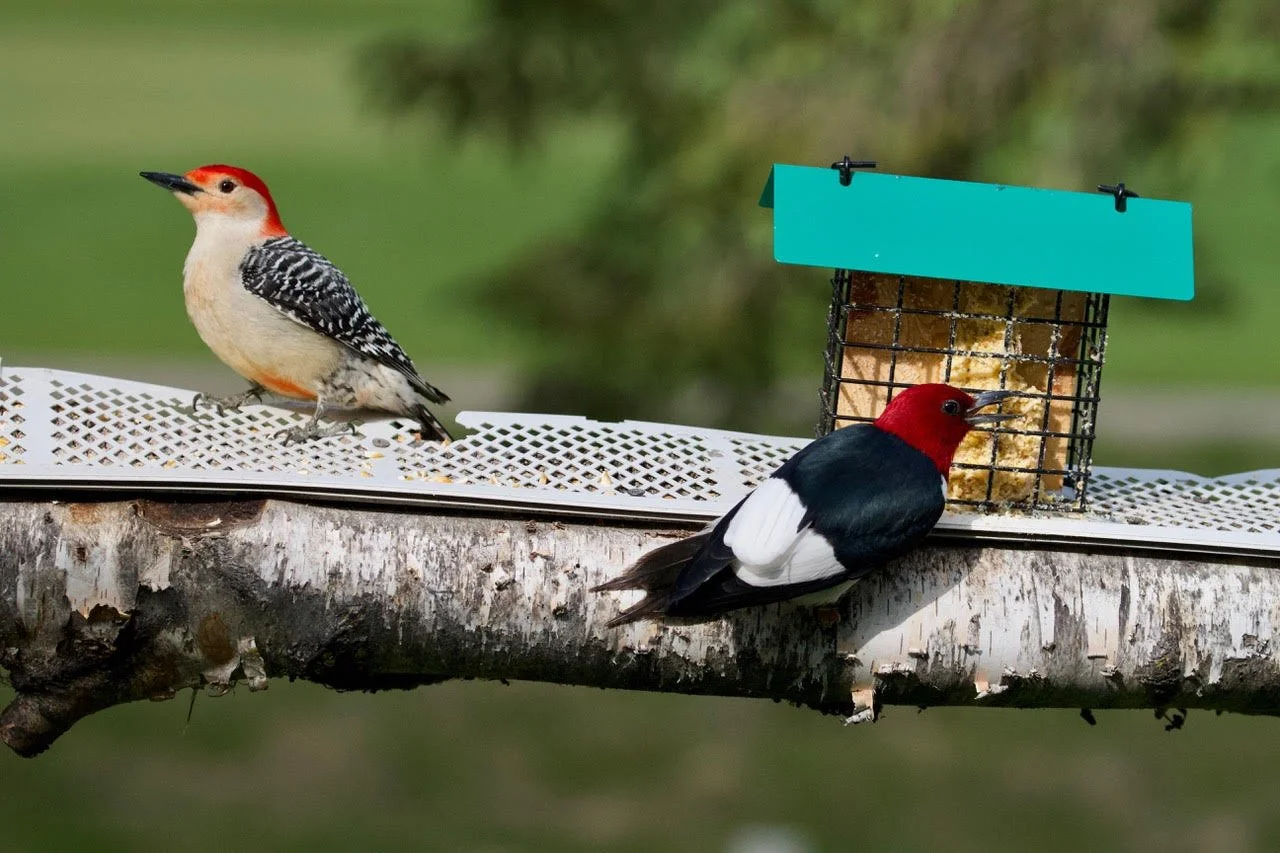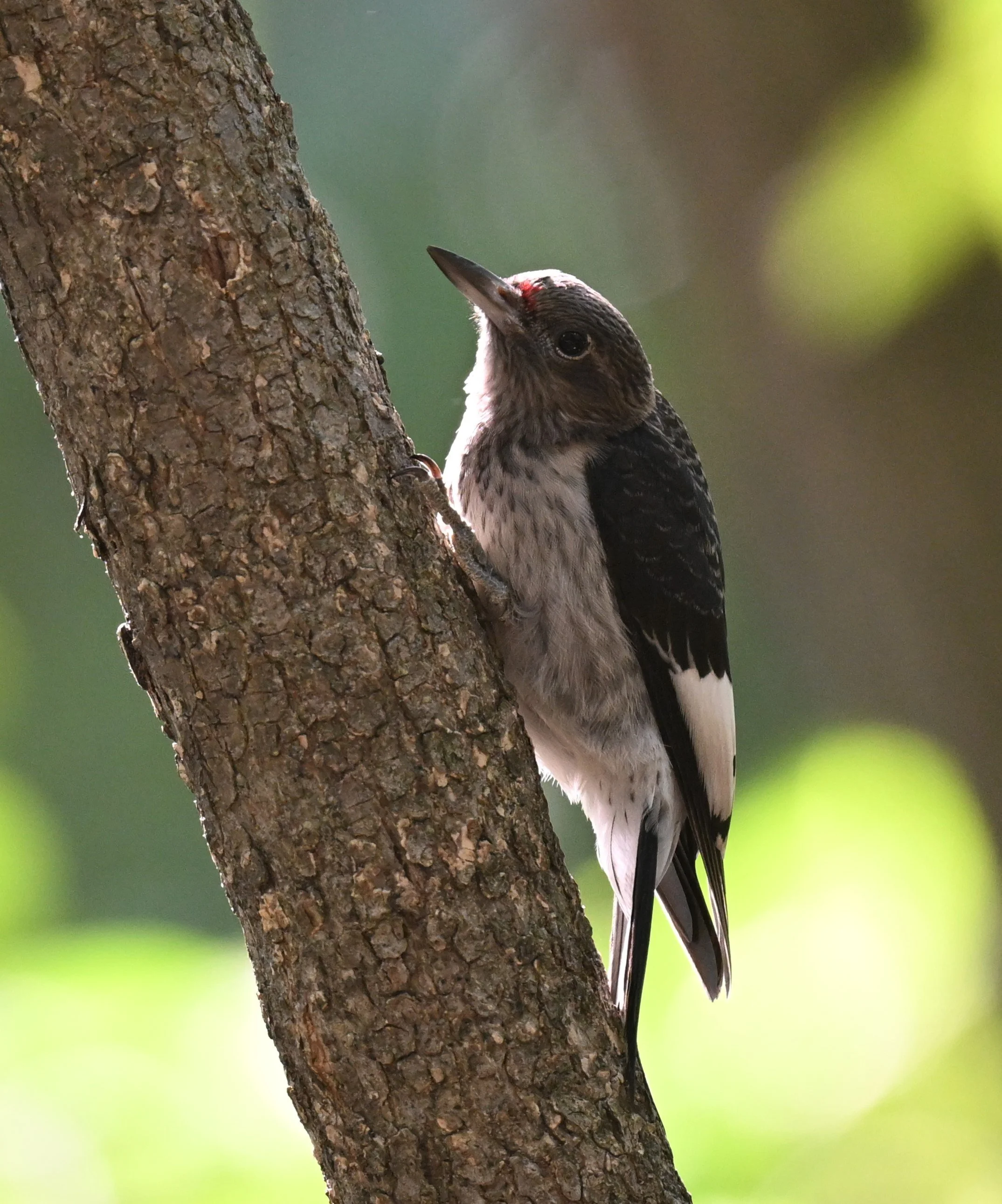We are very fortunate to have Red-headed Woodpeckers—our favorite oak woodland and savanna species—at our Wildland cabin year round for the past couple of years. These colorful birds are easy to identify with their blocky red, white, and black color pattern. The adult females and males are the same color and the juveniles are grayish with white wings. Their most common call—a shrill, hoarse tchur—sounds similar to a Red-bellied Woodpecker, but is higher in pitch and less rolling. They call frequently during nesting season from dawn until dark.
A Red-bellied Woodpecker (left) and a Red-headed Woodpecker (right) visit a suet feeder (photo by Stephen Lang). Though both birds have red on their heads, note the small patch of red on the underside of the red-bellied.
Red-headed Woodpecker numbers have changed over the past 200 years. John James Audubon reported that on one day in 1840, 100 were shot from a single cherry tree at an orchard, an example of how abundant they were at the time. From 1966 to 2019, their population declined by 54% according to federal breeding bird surveys. Some of the reasons for this may be related to their habitat and food sources.
Juvenile Red-Headed Woodpecker (photo by Andy Reago & Chrissy McClarren).
These woodpeckers eat a variety of fruits and nuts. Previously abundant crops of chestnut, beech nuts, and acorns could be found throughout their range, but availability decreased due to the chestnut blight and loss of many old-growth beech forests. Another significant portion of the red-head’s diet comes from insects, which they either catch in midair like a flycatcher or forage for near the ground. We have observed that they like to feed along roadsides, which puts them at risk of being hit by cars. From 1932 to 1949, A. W. Schorger recorded every bird he found dead on southern Wisconsin roads. He found more Red-headed Woodpeckers than any other species except for House Sparrow.
Red-heads nest mostly in the dead parts of trees or snags in open-forest habitats, and often return to the same sites each year. Once we found a pair nesting in the only tree in the middle of a large grassy field. They would fly a hundred yards or more to the woodlot edges to hunt for insects. In the 1950s and 1960s, Red-headed Woodpeckers were very common in oak woods grazed by cattle. As grazing decreased, shrubs and trees filled in open areas. Also around that time, increasing competition from European Starlings for nest sites and removal of trees for logging or due to diseases like Dutch elm resulted in fewer birds.
The Red-Headed Woodpecker can mostly be found east of the Rockies (map graphic courtesy of Cornell Lab of Ornithology).
In the Wisconsin Breeding Bird Atlas (1995–2000), red-heads were usually found in the driftless area and were uncommon in Columbia County. During the Wisconsin Breeding Bird Atlas II (2015–2019) they were confirmed nesting in 18 of the 85 atlas blocks and 8 of the 18 priority blocks, but we still considered them uncommon. We made a special effort to confirm nesting—if we saw an adult when driving in Columbia County, we revisited the site to look for feeding activity. We remember observing adults catching insects in flight and placing them in a crack of a utility pole. After a few minutes the bird would gather a mouthful of prey from the pole and carry it to the nest.
In the past five years, we have seen a noticeable increase in Red-headed Woodpeckers. There are three pairs nesting on the oak woodland and savanna habitats on our Wildland property and we estimate six more pairs are nesting in the area within a half mile. This year, there are also two nesting pairs at Otsego Marsh and two pairs at Hillside Prairie Sanctuary. At the 780-acre complex that includes both Erstad Prairie and the Schoeneberg Marsh Waterfowl Production Area, you can also typically find them in the areas where high water killed the trees along the wetland edges. At Goose Pond Sanctuary, there were two eBird observations between 2010 and 2019 (we have been the managers at Goose Pond since 1979 and we saw our first Red-headed Woodpecker in May 2016); from 2020 to 2024 they were reported in three of the years.
This year, the acorn crop looks very good. Be sure to check out oak woodlots or savanna restorations to find this colorful and interesting bird.
Written by Mark Martin and Susan Foote-Martin, Goose Pond sanctuary managers.
Cover image by Jeff Galligan. A Red-headed Woodpecker holding an insect flies overhead on a blue-sky day.








